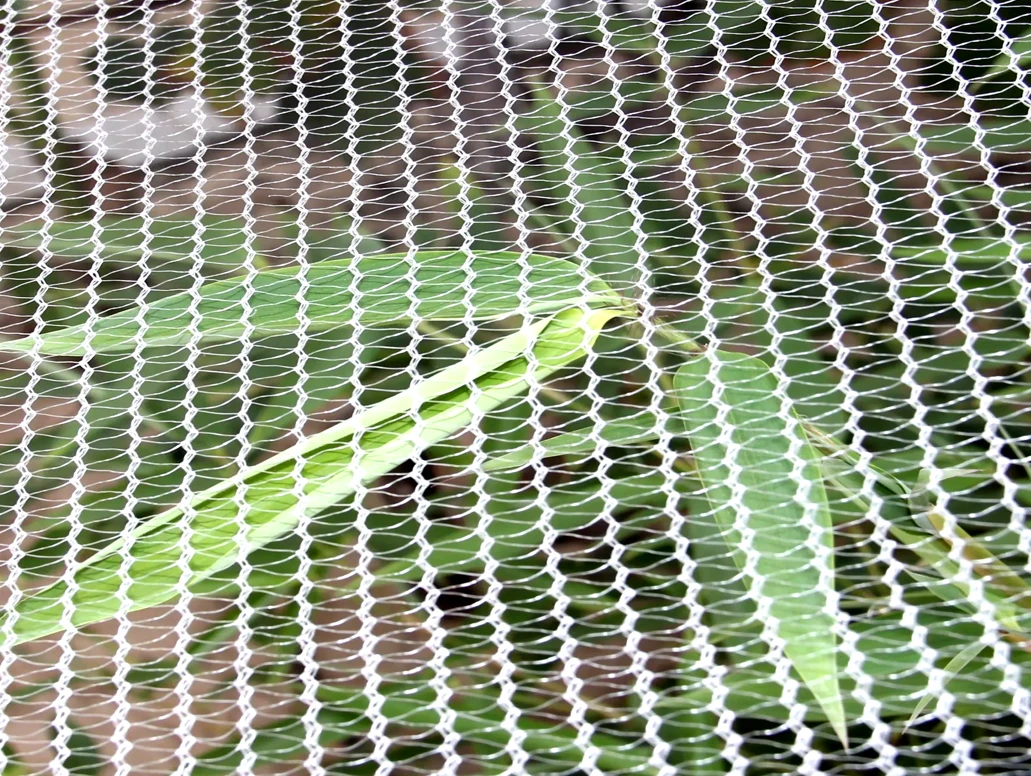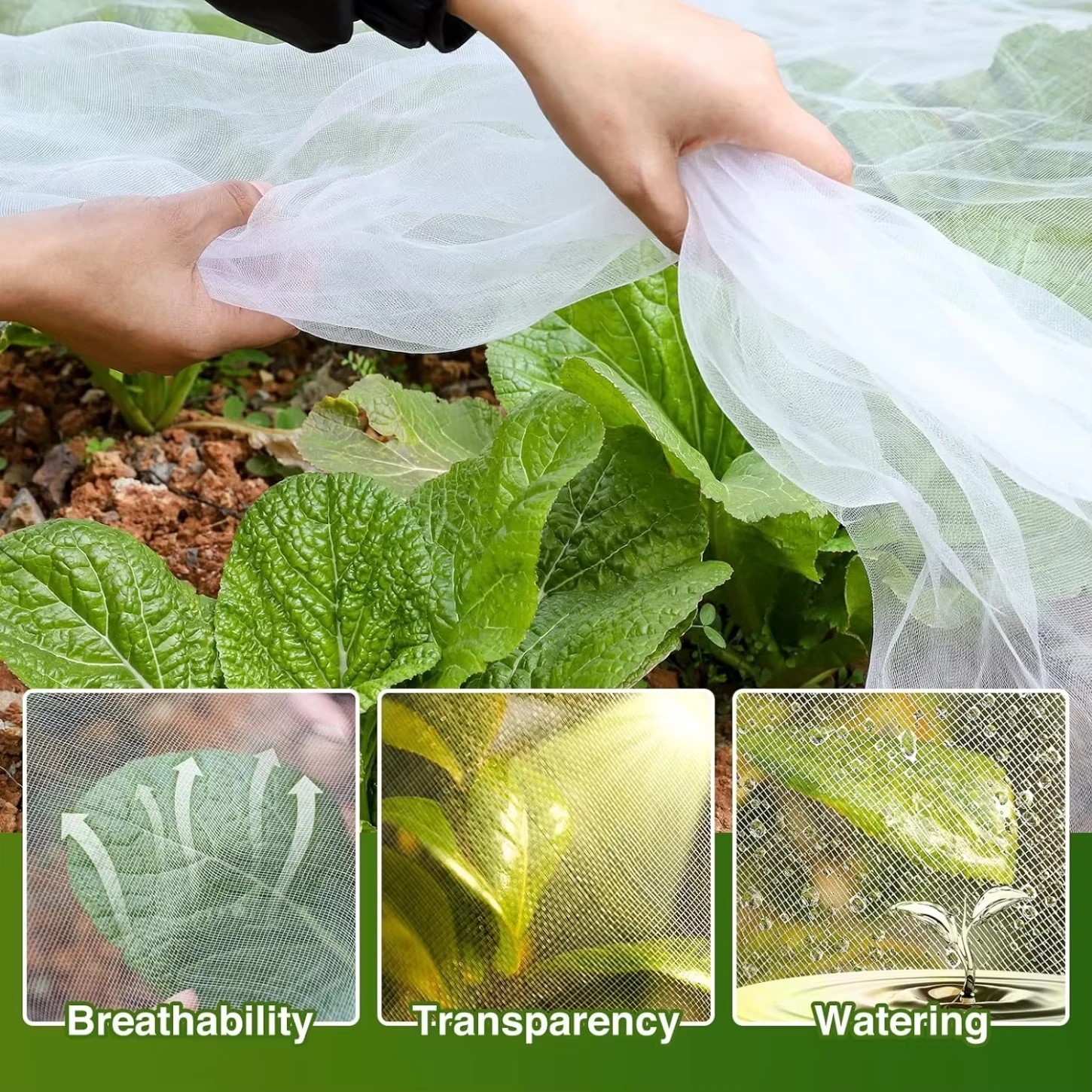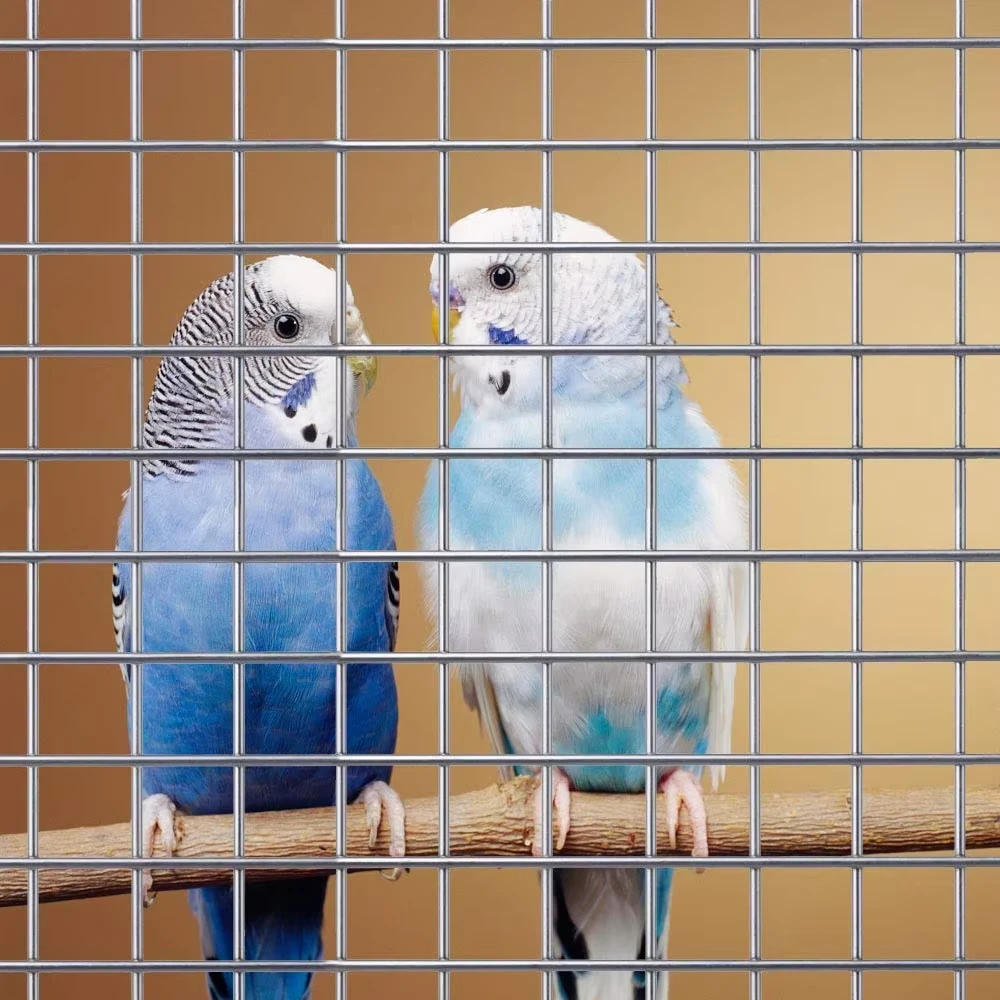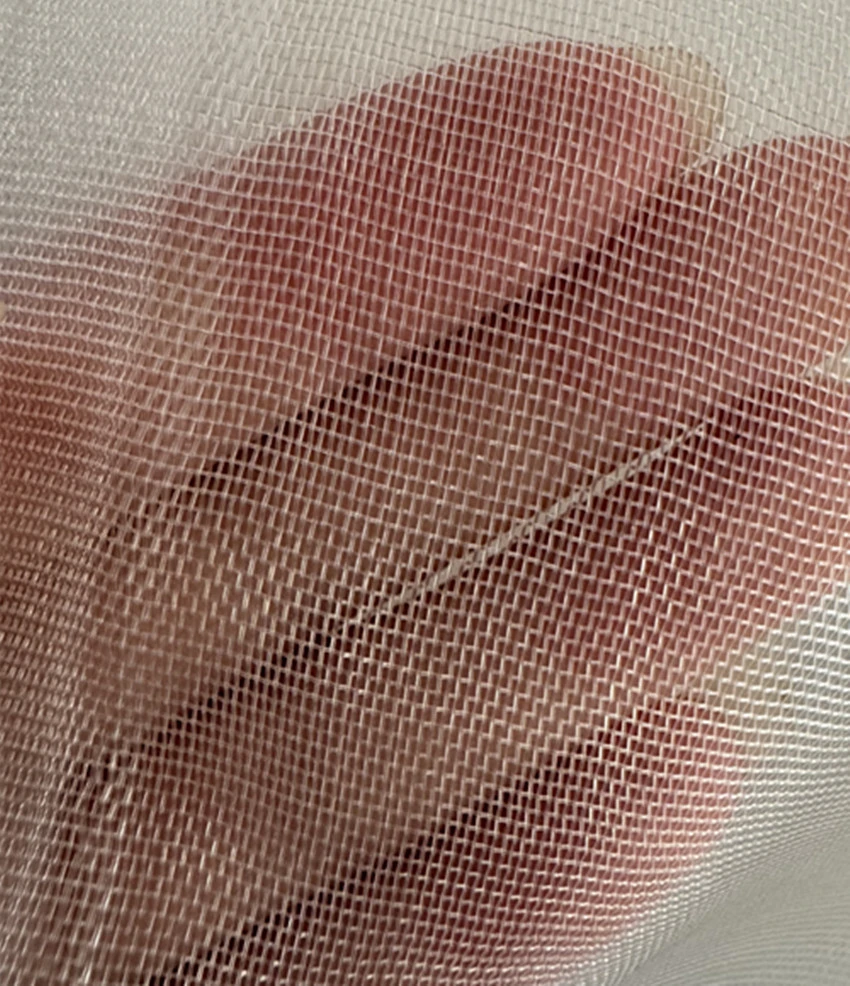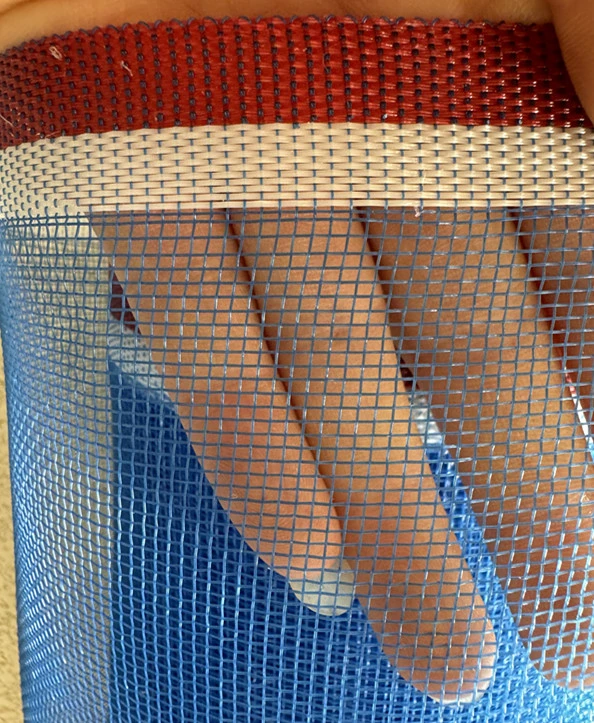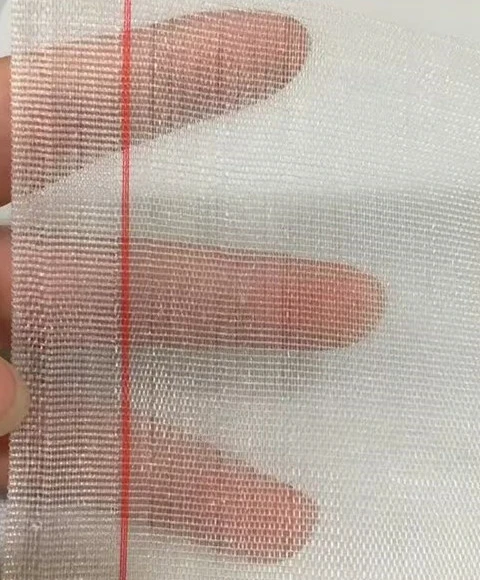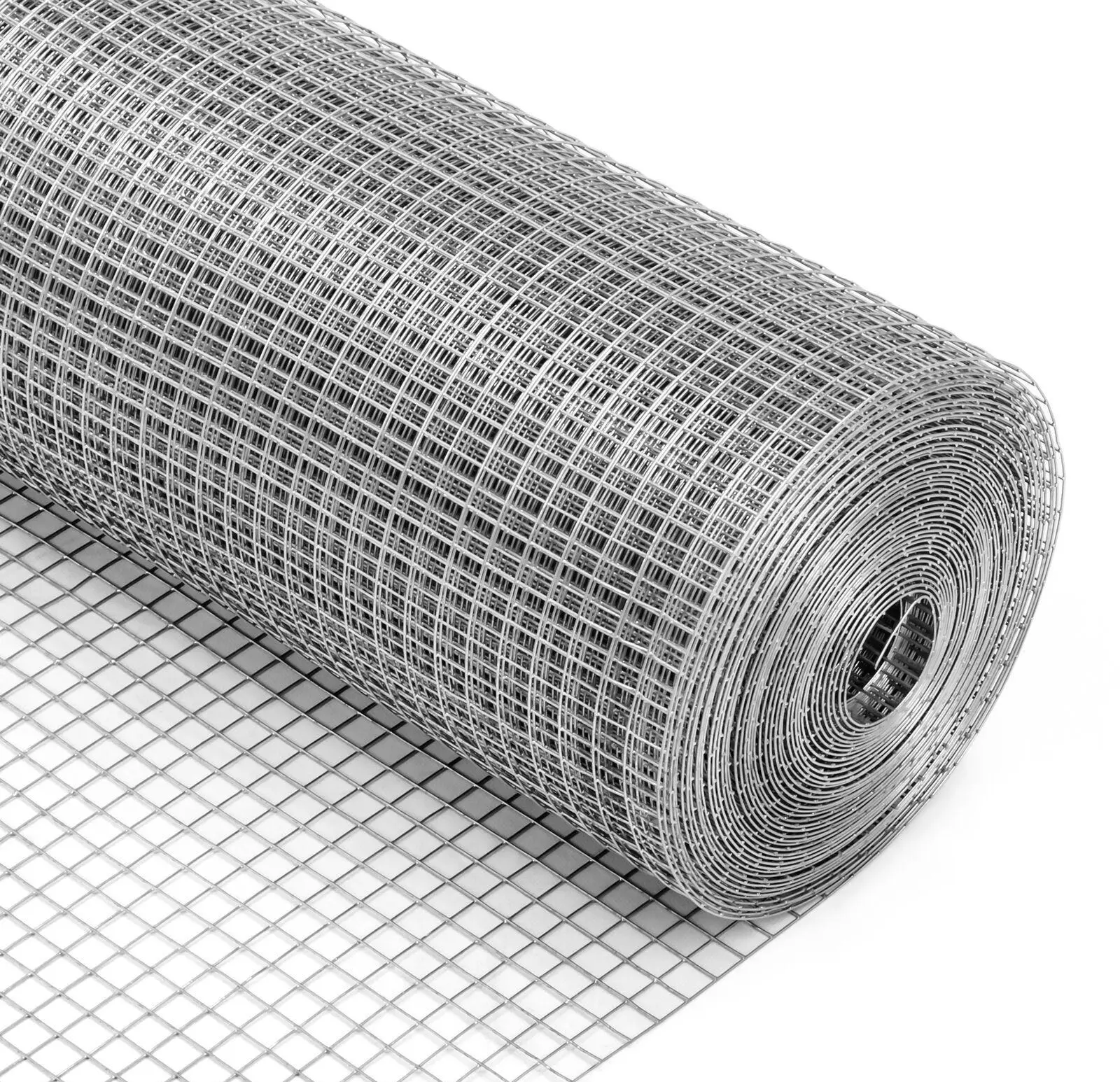Durable Insect Net: Superior Protection Against Pests
Introduction to Advanced Insect Netting Solutions
In modern agriculture, particularly within controlled environment agriculture (CEA) and greenhouse operations, the strategic deployment of protective measures against pests is paramount. The insect net stands as a critical barrier, safeguarding crops from a wide array of insect infestations while simultaneously facilitating essential environmental controls such as ventilation and light transmission. This comprehensive overview delves into the intricate world of advanced insect netting, covering its manufacturing process, technical specifications, diverse application scenarios, and the tangible advantages it offers to B2B stakeholders in the agricultural sector. Our focus is on providing detailed insights that empower decision-makers to select optimal solutions for enhanced crop yield and operational efficiency.
Current Industry Trends in Insect Netting Technology
The agricultural sector is experiencing a significant shift towards sustainable and chemical-free pest management. This paradigm shift directly fuels innovation in physical barriers like the insect net. Key trends include the development of finer mesh sizes to combat smaller, more resilient pests (e.g., thrips, whiteflies), the integration of UV-stabilized materials for extended durability, and the engineering of nets with specific optical properties to optimize plant growth while still deterring insects. There's also a growing demand for customized solutions that adapt to diverse greenhouse structures and crop types, moving beyond one-size-fits-all products. Furthermore, advancements in polymer science are leading to the creation of lighter, yet stronger materials, reducing structural load on greenhouses and simplifying installation. The global market for agricultural netting, including advanced insect cage mesh, is projected to grow at a Compound Annual Growth Rate (CAGR) of over 5% from 2023 to 2028, driven by increasing awareness of pesticide residues and the need for climate-resilient farming practices.

Detailed Manufacturing Process of High-Quality Greenhouse Insect Net
The production of a robust and effective insect proof net involves a meticulously controlled multi-stage process, ensuring both efficacy and longevity. The "Good Quality Greenhouse Insect Net for Vegetable" exemplifies this commitment to excellence.
Materials and Extrusion:
The foundation of our superior nets insect is high-density polyethylene (HDPE) virgin resin. This specific polymer is chosen for its excellent strength-to-weight ratio, chemical inertness, UV resistance, and flexibility. The process begins with the extrusion of HDPE granules into monofilaments. Precision extrusion machinery ensures uniform filament diameter, which is critical for consistent mesh size and overall structural integrity. Stabilizers and UV inhibitors are compounded directly into the resin during this stage, imparting crucial resistance against photodegradation from prolonged sun exposure, significantly extending the service life.
Weaving/Knitting Process:
Following extrusion, the monofilaments are woven or knitted into the desired mesh pattern. For greenhouse applications, fine mesh knitting machines are typically employed to create a tight, uniform fabric. This knitting process results in a tear-resistant and unravel-proof structure, which is vital for long-term performance under environmental stresses. The mesh density, often specified as `insect net mesh 50` (50 holes per inch), directly dictates the size of insects that can be excluded. Our nets are precisely engineered to specific mesh counts to block common pests such as whiteflies, thrips, aphids, and leaf miners, without excessively impeding airflow or light penetration.
Quality Control and Testing Standards:
Each production batch undergoes rigorous testing to meet stringent international standards, including ISO 9001:2015 for quality management. Key tests include:
- Mesh Size Analysis: Verified using optical microscopy to ensure accurate hole size (e.g., 0.25mm x 0.75mm for 50-mesh).
- Tensile Strength Testing (ASTM D5034): To confirm resistance to tearing and stretching under tension.
- UV Resistance Testing (ASTM G154): Accelerated weathering tests simulate years of sun exposure to predict service life, typically guaranteeing 5+ years of effective performance.
- Air Permeability: Measured to ensure adequate ventilation while maintaining pest exclusion.
- Shade Factor: Evaluated to ensure minimal light reduction for optimal crop growth.
Finishing and Packaging:
After weaving and testing, the nets are cut to specified dimensions, often with reinforced selvages to prevent fraying and facilitate secure installation. They are then carefully rolled and packaged to prevent damage during transit.
Target Industries and Advantages:
Our products primarily serve the horticulture, floriculture, and vegetable farming industries, especially those utilizing greenhouses or shade net houses. In these scenarios, the primary advantages include:
- Energy Saving: By reducing the need for chemical pest control applications, operational costs are significantly lowered.
- Corrosion Resistance: HDPE is inherently resistant to most chemicals, acids, and alkalis, ensuring durability even in environments where fertilizers and pesticides might be used (though their need is drastically reduced).
- Enhanced Crop Health: A pest-free environment leads to healthier plants, higher yields, and improved product quality.
- Environmental Sustainability: Reduces reliance on synthetic pesticides, promoting ecological balance and consumer safety.

Technical Specifications and Performance Parameters
Understanding the precise technical parameters of a greenhouse insect proof mesh is essential for optimal selection and deployment. Our "Good Quality Greenhouse Insect Net for Vegetable" is engineered for peak performance, balancing pest exclusion with crucial environmental factors.
Key Product Specifications:
| Parameter | Specification | Unit/Standard |
|---|---|---|
| Material | 100% Virgin HDPE with UV Stabilizer | N/A |
| Mesh Count (Fineness) | 40 Mesh / 50 Mesh (standard options) | Holes per Inch |
| Hole Size (Approx.) | 0.25mm x 0.75mm (for 50 Mesh) | Millimeters (mm) |
| Weight | 100 gsm - 150 gsm (customizable) | Grams per Square Meter (gsm) |
| Standard Widths | 1m, 1.5m, 2m, 3m, 4m, 6m (up to 8m available) | Meters (m) |
| Standard Lengths | 50m, 100m, 200m (customizable) | Meters (m) |
| UV Resistance | 5-year+ UV guarantee (under normal conditions) | Years |
| Shade Factor | Typically 10-15% (varies with mesh size) | Percentage (%) |
| Color | Transparent, White (standard), Green, Black (custom) | N/A |
These specifications ensure that the insect net provides an effective physical barrier against pests while maintaining optimal conditions for plant growth. The precise mesh size, such as insect net mesh 50, is crucial for excluding target pests like whiteflies (average size 1.0mm), aphids (average size 2.0-4.0mm), and thrips (average size 0.5-1.5mm), which are major threats to vegetable crops. The UV stabilization is key to the product's return on investment, preventing premature degradation and maintaining structural integrity over multiple growing seasons.
Application Scenarios and Practical Implementations
The versatility of high-quality nets insect extends across a myriad of agricultural and horticultural settings, providing tailored protection for diverse cultivation needs.
- Greenhouse Vents and Openings: The most common application involves covering all natural ventilation openings, roll-up sides, and roof vents of greenhouses. This creates a secure barrier, preventing pests from entering the controlled environment while allowing crucial airflow to regulate temperature and humidity.
- Tunnels and Walk-in Tunnels: For smaller-scale protected cultivation, insect proof net is stretched over hoops or framework to create insect-proof tunnels, ideal for organic vegetable production where chemical sprays are prohibited.
- Net Houses/Screen Houses: In regions with high pest pressure or intense sunlight, entire structures are built with insect nets as the primary cladding. These "net houses" offer significant protection while promoting natural ventilation.
- Crop Covers (Direct Field Application): Lighter weight insect cage mesh can be draped directly over young plants in open fields. This method protects seedlings from early-season pests and birds, fostering vigorous growth before potential pest outbreaks.
- Seedling Nurseries: Protecting delicate seedlings from insect vectors is crucial for establishing healthy crops. Insect nets are extensively used in propagation areas to ensure disease-free starts.
These applications collectively highlight the ability of advanced netting solutions to minimize crop damage, reduce reliance on pesticides, and contribute to higher quality produce, ensuring sustainability and profitability for growers.
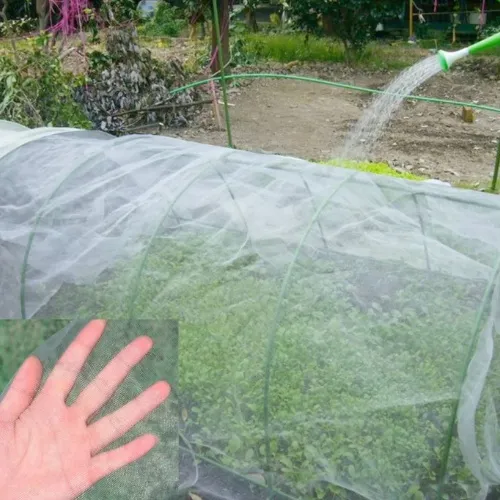
Technical Advantages and Economic Impact
The deployment of high-performance insect net provides multifaceted benefits that extend beyond mere pest exclusion, significantly impacting operational economics and environmental stewardship.
- Superior Pest Exclusion: The primary advantage is the creation of a physical barrier effective against a broad spectrum of insect pests, including tiny vectors like thrips and whiteflies, which are notorious for transmitting plant viruses. This drastically reduces crop damage and yield losses.
- Reduced Pesticide Dependency: By preventing pest entry, the need for chemical insecticides is significantly minimized or eliminated. This translates to lower input costs, safer working conditions for farm labor, and healthier produce free from chemical residues, appealing to organic markets.
- Optimized Ventilation & Microclimate Control: While fine, the specialized weave of our insect proof mesh is designed to allow adequate airflow, preventing heat buildup and maintaining optimal temperatures and humidity levels within the protected environment. This passive climate control is crucial for plant physiology.
- Enhanced UV Stability and Longevity: Incorporating advanced UV stabilizers in the HDPE material ensures that the netting withstands harsh solar radiation for many years (5+ years guaranteed), offering a durable, long-term solution with an excellent return on investment.
- Improved Crop Quality and Yield: A pest-free environment leads to less stress on plants, resulting in vigorous growth, fewer blemishes, and higher marketable yields. This directly translates to increased profitability for growers.
- Water Conservation: In some applications, reduced pest pressure also means less need for foliar pesticide applications, which can sometimes lead to water runoff or evaporation.
From an economic perspective, the initial investment in a quality insect net is rapidly offset by savings in pesticide costs, reduced labor for application, higher quality produce commanding better market prices, and fewer crop losses.
Vendor Comparison and Selection Criteria
Selecting the right supplier for agricultural insect proof net is a strategic decision that impacts long-term operational efficiency and profitability. While many vendors offer netting solutions, discerning buyers must evaluate several critical factors.
Key Comparison Parameters for Insect Net Vendors:
| Feature/Criterion | Generic Vendor Offerings | Our "Good Quality Greenhouse Insect Net" (YJ Wire Mesh) |
|---|---|---|
| Material Quality | Recycled or mixed-grade HDPE, limited UV protection. | 100% Virgin HDPE with industry-leading UV stabilizers. Consistent quality. |
| UV Lifespan Guarantee | 1-3 years, often unspecified or conditional. | 5+ years UV stability guarantee, verified by accelerated weathering tests (ASTM G154). |
| Mesh Uniformity | Inconsistent mesh size, potential gaps, varying pest exclusion. | Precision knitting technology ensures uniform mesh (e.g., insect net mesh 50) for reliable pest exclusion. |
| Tear & Puncture Resistance | Fragile, prone to tearing under stress, short field life. | High tensile strength, unravel-proof knit construction, reducing field damage. |
| Customization Options | Limited standard sizes and colors only. | Extensive customization in width, length, mesh size, weight, and color to fit specific project needs. |
| Certifications & Standards | Few or no internationally recognized certifications. | ISO 9001:2015 certified processes, adherence to ASTM testing for material properties. |
| Technical Support | Basic product information, limited application guidance. | Dedicated technical team for consultation, project design assistance, and after-sales support. |
Choosing a reputable vendor means investing in a product that not only performs as expected but also provides long-term value, supported by robust technical expertise and customer service. Our commitment to transparent specifications and rigorous quality control differentiates our offerings in the competitive market for nets insect.
Customized Solutions for Diverse Agricultural Needs
Recognizing that no two agricultural operations are identical, we specialize in providing highly customized insect net solutions. Our engineering team collaborates closely with clients to develop netting that perfectly integrates with their unique greenhouse structures, crop types, and regional pest pressures. This bespoke approach ensures maximum effectiveness and cost-efficiency.
- Tailored Dimensions: We offer netting in custom widths and lengths, minimizing waste and simplifying installation for specific greenhouse designs, high tunnels, or large field covers. This includes extra-wide rolls for seamless installation over large structures.
- Optimized Mesh Sizes: While insect net mesh 50 is a popular choice, we can produce different mesh counts to target specific pest profiles. For example, finer meshes for microscopic pests or slightly larger meshes for improved ventilation where pest pressure allows.
- Variable Weight and Durability: Depending on the intended application and environmental conditions, we can adjust the weight (GSM) of the fabric, enhancing tear strength for high-stress areas or optimizing for lighter, more breathable applications.
- Color Options: While transparent and white are standard for light transmission, specific projects might benefit from green (for shading) or black (for light deprivation or other aesthetic/functional needs), which we can provide.
- Reinforced Edges and Eyelets: For applications requiring frequent handling or secure fastening, we offer reinforced selvages and integrated eyelets to enhance durability and ease of installation.
Our consultative approach ensures that clients receive not just a product, but a precision-engineered solution that directly addresses their challenges and optimizes their cultivation environment.

Application Case Studies and Customer Success
Our commitment to quality and custom solutions has translated into significant success for our clients worldwide. These case studies demonstrate the tangible benefits of integrating our advanced insect net.
Case Study 1: Large-Scale Organic Tomato Farm, Southern Europe
Challenge: A major organic tomato producer in Italy faced recurring severe infestations of whiteflies and thrips, leading to significant crop losses and threatening their organic certification due to the need for biological controls that were sometimes overwhelmed.
Solution: We supplied custom-sized "Good Quality Greenhouse Insect Net for Vegetable" with a precise insect net mesh 50 for all greenhouse vents and doorways. The nets were installed across 10 hectares of greenhouse space.
Results: Within the first season, pest incidence dropped by over 90%. The farm reported a 20% increase in marketable yield due to reduced damage and an average 35% reduction in biological control agent costs. The farm maintained its organic certification with greater ease and stability. The client, Mr. Giovanni Rossi, noted, "The installation of these nets was a game-changer. Our pest pressure is now manageable, and our produce quality has never been better."
Case Study 2: Hydroponic Lettuce Facility, Middle East
Challenge: A state-of-the-art hydroponic lettuce facility in the UAE required absolute protection from dust and fine airborne pests, including small midges and fungal gnats, which thrived in the humid climate, contaminating water systems and affecting sensitive crops.
Solution: We provided a bespoke ultra-fine insect proof mesh specifically designed to exclude even the smallest airborne particles, while maintaining critical passive cooling through ventilation in the arid climate.
Results: The facility achieved near-zero pest ingress, preventing contamination and ensuring optimal growth conditions. Crop spoilage due to pests was virtually eliminated, leading to consistent, high-volume production. "The precision netting from YJ Wire Mesh allowed us to create a truly sterile growing environment, crucial for our high-value produce," commented the facility manager.

Frequently Asked Questions (FAQ)
Q: What mesh size is recommended for general vegetable protection?
A: For broad-spectrum protection against common pests like whiteflies, aphids, thrips, and leaf miners, a 50 mesh insect net is highly effective. For regions with extremely small or specific pests, finer meshes can be specified.
Q: How long can I expect the insect net to last?
A: Our "Good Quality Greenhouse Insect Net for Vegetable" is made from 100% virgin HDPE with advanced UV stabilizers, guaranteeing a service life of 5 years or more under typical outdoor conditions. Proper installation and maintenance can extend this lifespan.
Q: Does the netting significantly reduce light penetration?
A: Our insect proof mesh is engineered to minimize light reduction, typically resulting in only 10-15% shading depending on mesh size and color. This ensures adequate light for photosynthesis while effectively blocking pests. Transparent or white nets offer the least shading.
Q: Can your nets be customized for specific greenhouse dimensions?
A: Absolutely. We offer extensive customization options, including various widths (up to 8 meters), lengths, mesh sizes, and even colors, to perfectly match your project requirements. Contact our technical sales team for bespoke solutions.
Lead Time, Warranty, and Customer Support
Lead Time & Fulfillment:
We maintain efficient production lines and robust inventory management to ensure timely delivery. Standard orders for our "Good Quality Greenhouse Insect Net for Vegetable" typically have a lead time of 10-15 business days. For large-volume or highly customized orders, lead times will be confirmed upon order placement, with an estimated range of 20-30 business days. We partner with reliable logistics providers to ensure secure and prompt global shipping.
Warranty Commitments:
All our insect net products come with a comprehensive warranty. We guarantee our netting will maintain its UV stability and structural integrity for a minimum of 5 years from the date of purchase, under normal agricultural usage and environmental conditions. This warranty covers manufacturing defects and premature degradation due to UV exposure. Full warranty terms and conditions are available upon request.
Customer Support:
Our dedicated customer support team is available to assist with all inquiries, from initial product selection and technical specifications to order tracking and after-sales service. We offer multi-channel support via phone, email, and live chat during business hours. Our technical experts are also available for consultation on complex projects or installation guidance, ensuring you maximize the benefits of your insect proof net investment.
Conclusion
The implementation of advanced insect net solutions represents a crucial strategic investment for modern agricultural enterprises. By providing an impenetrable barrier against a wide array of pests, optimizing environmental conditions, and significantly reducing reliance on chemical interventions, these nets contribute directly to sustainable farming practices, increased crop yields, and enhanced profitability. Our "Good Quality Greenhouse Insect Net for Vegetable" exemplifies superior material science and manufacturing precision, offering unparalleled durability, performance, and long-term value. Partnering with a trusted provider ensures access to not only high-quality products but also expert technical support and customized solutions, empowering growers to thrive in an evolving agricultural landscape.
References
- FAO (Food and Agriculture Organization of the United Nations). "Protected Cultivation in Tropical and Subtropical Areas." FAO Plant Production and Protection Paper, No. 200, 2010.
- Council of European Biocontrol Industry (CEBIO). "The Role of Physical Barriers in Integrated Pest Management." Technical Bulletin, 2022.
- ASTM International. "Standard Guide for Outdoor Exposure Testing of Photovoltaic Modules." ASTM G154-16, 2016.
- ISO (International Organization for Standardization). "Quality management systems — Requirements." ISO 9001:2015, 2015.
- Ghahari, S., & Rezaei, M. (2019). "Effects of different insect-proof nettings on microclimate, yield and quality of greenhouse cucumber." Journal of Agricultural Science and Technology, 21(5), 1435-1447.
- "Global Agricultural Netting Market Outlook 2023-2028." Mordor Intelligence, 2023.
-
Anti Hail Net | UV-Stable, High-Strength Orchard ShieldNewsNov.17,2025
-
Anti Bird Netting – UV-Stable, Durable, Humane ProtectionNewsNov.17,2025
-
Welded Wire - Durable, Rust-Resistant Mesh, Custom SizesNewsNov.17,2025
-
Garden Mesh Sun Shade – UV-Resistant, Durable, Custom SizesNewsNov.17,2025
-
Bird in Net Solution: Humane, UV-Resistant Bird NettingNewsNov.17,2025
-
Stainless Steel Filters: Durable, Washable, High-FlowNewsNov.10,2025
Durable Insect Net: Superior Protection Against Pests
Introduction to Advanced Insect Netting Solutions
In modern agriculture, particularly within controlled environment agriculture (CEA) and greenhouse operations, the strategic deployment of protective measures against pests is paramount. The insect net stands as a critical barrier, safeguarding crops from a wide array of insect infestations while simultaneously facilitating essential environmental controls such as ventilation and light transmission. This comprehensive overview delves into the intricate world of advanced insect netting, covering its manufacturing process, technical specifications, diverse application scenarios, and the tangible advantages it offers to B2B stakeholders in the agricultural sector. Our focus is on providing detailed insights that empower decision-makers to select optimal solutions for enhanced crop yield and operational efficiency.
Current Industry Trends in Insect Netting Technology
The agricultural sector is experiencing a significant shift towards sustainable and chemical-free pest management. This paradigm shift directly fuels innovation in physical barriers like the insect net. Key trends include the development of finer mesh sizes to combat smaller, more resilient pests (e.g., thrips, whiteflies), the integration of UV-stabilized materials for extended durability, and the engineering of nets with specific optical properties to optimize plant growth while still deterring insects. There's also a growing demand for customized solutions that adapt to diverse greenhouse structures and crop types, moving beyond one-size-fits-all products. Furthermore, advancements in polymer science are leading to the creation of lighter, yet stronger materials, reducing structural load on greenhouses and simplifying installation. The global market for agricultural netting, including advanced insect cage mesh, is projected to grow at a Compound Annual Growth Rate (CAGR) of over 5% from 2023 to 2028, driven by increasing awareness of pesticide residues and the need for climate-resilient farming practices.

Detailed Manufacturing Process of High-Quality Greenhouse Insect Net
The production of a robust and effective insect proof net involves a meticulously controlled multi-stage process, ensuring both efficacy and longevity. The "Good Quality Greenhouse Insect Net for Vegetable" exemplifies this commitment to excellence.
Materials and Extrusion:
The foundation of our superior nets insect is high-density polyethylene (HDPE) virgin resin. This specific polymer is chosen for its excellent strength-to-weight ratio, chemical inertness, UV resistance, and flexibility. The process begins with the extrusion of HDPE granules into monofilaments. Precision extrusion machinery ensures uniform filament diameter, which is critical for consistent mesh size and overall structural integrity. Stabilizers and UV inhibitors are compounded directly into the resin during this stage, imparting crucial resistance against photodegradation from prolonged sun exposure, significantly extending the service life.
Weaving/Knitting Process:
Following extrusion, the monofilaments are woven or knitted into the desired mesh pattern. For greenhouse applications, fine mesh knitting machines are typically employed to create a tight, uniform fabric. This knitting process results in a tear-resistant and unravel-proof structure, which is vital for long-term performance under environmental stresses. The mesh density, often specified as `insect net mesh 50` (50 holes per inch), directly dictates the size of insects that can be excluded. Our nets are precisely engineered to specific mesh counts to block common pests such as whiteflies, thrips, aphids, and leaf miners, without excessively impeding airflow or light penetration.
Quality Control and Testing Standards:
Each production batch undergoes rigorous testing to meet stringent international standards, including ISO 9001:2015 for quality management. Key tests include:
- Mesh Size Analysis: Verified using optical microscopy to ensure accurate hole size (e.g., 0.25mm x 0.75mm for 50-mesh).
- Tensile Strength Testing (ASTM D5034): To confirm resistance to tearing and stretching under tension.
- UV Resistance Testing (ASTM G154): Accelerated weathering tests simulate years of sun exposure to predict service life, typically guaranteeing 5+ years of effective performance.
- Air Permeability: Measured to ensure adequate ventilation while maintaining pest exclusion.
- Shade Factor: Evaluated to ensure minimal light reduction for optimal crop growth.
Finishing and Packaging:
After weaving and testing, the nets are cut to specified dimensions, often with reinforced selvages to prevent fraying and facilitate secure installation. They are then carefully rolled and packaged to prevent damage during transit.
Target Industries and Advantages:
Our products primarily serve the horticulture, floriculture, and vegetable farming industries, especially those utilizing greenhouses or shade net houses. In these scenarios, the primary advantages include:
- Energy Saving: By reducing the need for chemical pest control applications, operational costs are significantly lowered.
- Corrosion Resistance: HDPE is inherently resistant to most chemicals, acids, and alkalis, ensuring durability even in environments where fertilizers and pesticides might be used (though their need is drastically reduced).
- Enhanced Crop Health: A pest-free environment leads to healthier plants, higher yields, and improved product quality.
- Environmental Sustainability: Reduces reliance on synthetic pesticides, promoting ecological balance and consumer safety.

Technical Specifications and Performance Parameters
Understanding the precise technical parameters of a greenhouse insect proof mesh is essential for optimal selection and deployment. Our "Good Quality Greenhouse Insect Net for Vegetable" is engineered for peak performance, balancing pest exclusion with crucial environmental factors.
Key Product Specifications:
| Parameter | Specification | Unit/Standard |
|---|---|---|
| Material | 100% Virgin HDPE with UV Stabilizer | N/A |
| Mesh Count (Fineness) | 40 Mesh / 50 Mesh (standard options) | Holes per Inch |
| Hole Size (Approx.) | 0.25mm x 0.75mm (for 50 Mesh) | Millimeters (mm) |
| Weight | 100 gsm - 150 gsm (customizable) | Grams per Square Meter (gsm) |
| Standard Widths | 1m, 1.5m, 2m, 3m, 4m, 6m (up to 8m available) | Meters (m) |
| Standard Lengths | 50m, 100m, 200m (customizable) | Meters (m) |
| UV Resistance | 5-year+ UV guarantee (under normal conditions) | Years |
| Shade Factor | Typically 10-15% (varies with mesh size) | Percentage (%) |
| Color | Transparent, White (standard), Green, Black (custom) | N/A |
These specifications ensure that the insect net provides an effective physical barrier against pests while maintaining optimal conditions for plant growth. The precise mesh size, such as insect net mesh 50, is crucial for excluding target pests like whiteflies (average size 1.0mm), aphids (average size 2.0-4.0mm), and thrips (average size 0.5-1.5mm), which are major threats to vegetable crops. The UV stabilization is key to the product's return on investment, preventing premature degradation and maintaining structural integrity over multiple growing seasons.
Application Scenarios and Practical Implementations
The versatility of high-quality nets insect extends across a myriad of agricultural and horticultural settings, providing tailored protection for diverse cultivation needs.
- Greenhouse Vents and Openings: The most common application involves covering all natural ventilation openings, roll-up sides, and roof vents of greenhouses. This creates a secure barrier, preventing pests from entering the controlled environment while allowing crucial airflow to regulate temperature and humidity.
- Tunnels and Walk-in Tunnels: For smaller-scale protected cultivation, insect proof net is stretched over hoops or framework to create insect-proof tunnels, ideal for organic vegetable production where chemical sprays are prohibited.
- Net Houses/Screen Houses: In regions with high pest pressure or intense sunlight, entire structures are built with insect nets as the primary cladding. These "net houses" offer significant protection while promoting natural ventilation.
- Crop Covers (Direct Field Application): Lighter weight insect cage mesh can be draped directly over young plants in open fields. This method protects seedlings from early-season pests and birds, fostering vigorous growth before potential pest outbreaks.
- Seedling Nurseries: Protecting delicate seedlings from insect vectors is crucial for establishing healthy crops. Insect nets are extensively used in propagation areas to ensure disease-free starts.
These applications collectively highlight the ability of advanced netting solutions to minimize crop damage, reduce reliance on pesticides, and contribute to higher quality produce, ensuring sustainability and profitability for growers.

Technical Advantages and Economic Impact
The deployment of high-performance insect net provides multifaceted benefits that extend beyond mere pest exclusion, significantly impacting operational economics and environmental stewardship.
- Superior Pest Exclusion: The primary advantage is the creation of a physical barrier effective against a broad spectrum of insect pests, including tiny vectors like thrips and whiteflies, which are notorious for transmitting plant viruses. This drastically reduces crop damage and yield losses.
- Reduced Pesticide Dependency: By preventing pest entry, the need for chemical insecticides is significantly minimized or eliminated. This translates to lower input costs, safer working conditions for farm labor, and healthier produce free from chemical residues, appealing to organic markets.
- Optimized Ventilation & Microclimate Control: While fine, the specialized weave of our insect proof mesh is designed to allow adequate airflow, preventing heat buildup and maintaining optimal temperatures and humidity levels within the protected environment. This passive climate control is crucial for plant physiology.
- Enhanced UV Stability and Longevity: Incorporating advanced UV stabilizers in the HDPE material ensures that the netting withstands harsh solar radiation for many years (5+ years guaranteed), offering a durable, long-term solution with an excellent return on investment.
- Improved Crop Quality and Yield: A pest-free environment leads to less stress on plants, resulting in vigorous growth, fewer blemishes, and higher marketable yields. This directly translates to increased profitability for growers.
- Water Conservation: In some applications, reduced pest pressure also means less need for foliar pesticide applications, which can sometimes lead to water runoff or evaporation.
From an economic perspective, the initial investment in a quality insect net is rapidly offset by savings in pesticide costs, reduced labor for application, higher quality produce commanding better market prices, and fewer crop losses.
Vendor Comparison and Selection Criteria
Selecting the right supplier for agricultural insect proof net is a strategic decision that impacts long-term operational efficiency and profitability. While many vendors offer netting solutions, discerning buyers must evaluate several critical factors.
Key Comparison Parameters for Insect Net Vendors:
| Feature/Criterion | Generic Vendor Offerings | Our "Good Quality Greenhouse Insect Net" (YJ Wire Mesh) |
|---|---|---|
| Material Quality | Recycled or mixed-grade HDPE, limited UV protection. | 100% Virgin HDPE with industry-leading UV stabilizers. Consistent quality. |
| UV Lifespan Guarantee | 1-3 years, often unspecified or conditional. | 5+ years UV stability guarantee, verified by accelerated weathering tests (ASTM G154). |
| Mesh Uniformity | Inconsistent mesh size, potential gaps, varying pest exclusion. | Precision knitting technology ensures uniform mesh (e.g., insect net mesh 50) for reliable pest exclusion. |
| Tear & Puncture Resistance | Fragile, prone to tearing under stress, short field life. | High tensile strength, unravel-proof knit construction, reducing field damage. |
| Customization Options | Limited standard sizes and colors only. | Extensive customization in width, length, mesh size, weight, and color to fit specific project needs. |
| Certifications & Standards | Few or no internationally recognized certifications. | ISO 9001:2015 certified processes, adherence to ASTM testing for material properties. |
| Technical Support | Basic product information, limited application guidance. | Dedicated technical team for consultation, project design assistance, and after-sales support. |
Choosing a reputable vendor means investing in a product that not only performs as expected but also provides long-term value, supported by robust technical expertise and customer service. Our commitment to transparent specifications and rigorous quality control differentiates our offerings in the competitive market for nets insect.
Customized Solutions for Diverse Agricultural Needs
Recognizing that no two agricultural operations are identical, we specialize in providing highly customized insect net solutions. Our engineering team collaborates closely with clients to develop netting that perfectly integrates with their unique greenhouse structures, crop types, and regional pest pressures. This bespoke approach ensures maximum effectiveness and cost-efficiency.
- Tailored Dimensions: We offer netting in custom widths and lengths, minimizing waste and simplifying installation for specific greenhouse designs, high tunnels, or large field covers. This includes extra-wide rolls for seamless installation over large structures.
- Optimized Mesh Sizes: While insect net mesh 50 is a popular choice, we can produce different mesh counts to target specific pest profiles. For example, finer meshes for microscopic pests or slightly larger meshes for improved ventilation where pest pressure allows.
- Variable Weight and Durability: Depending on the intended application and environmental conditions, we can adjust the weight (GSM) of the fabric, enhancing tear strength for high-stress areas or optimizing for lighter, more breathable applications.
- Color Options: While transparent and white are standard for light transmission, specific projects might benefit from green (for shading) or black (for light deprivation or other aesthetic/functional needs), which we can provide.
- Reinforced Edges and Eyelets: For applications requiring frequent handling or secure fastening, we offer reinforced selvages and integrated eyelets to enhance durability and ease of installation.
Our consultative approach ensures that clients receive not just a product, but a precision-engineered solution that directly addresses their challenges and optimizes their cultivation environment.

Application Case Studies and Customer Success
Our commitment to quality and custom solutions has translated into significant success for our clients worldwide. These case studies demonstrate the tangible benefits of integrating our advanced insect net.
Case Study 1: Large-Scale Organic Tomato Farm, Southern Europe
Challenge: A major organic tomato producer in Italy faced recurring severe infestations of whiteflies and thrips, leading to significant crop losses and threatening their organic certification due to the need for biological controls that were sometimes overwhelmed.
Solution: We supplied custom-sized "Good Quality Greenhouse Insect Net for Vegetable" with a precise insect net mesh 50 for all greenhouse vents and doorways. The nets were installed across 10 hectares of greenhouse space.
Results: Within the first season, pest incidence dropped by over 90%. The farm reported a 20% increase in marketable yield due to reduced damage and an average 35% reduction in biological control agent costs. The farm maintained its organic certification with greater ease and stability. The client, Mr. Giovanni Rossi, noted, "The installation of these nets was a game-changer. Our pest pressure is now manageable, and our produce quality has never been better."
Case Study 2: Hydroponic Lettuce Facility, Middle East
Challenge: A state-of-the-art hydroponic lettuce facility in the UAE required absolute protection from dust and fine airborne pests, including small midges and fungal gnats, which thrived in the humid climate, contaminating water systems and affecting sensitive crops.
Solution: We provided a bespoke ultra-fine insect proof mesh specifically designed to exclude even the smallest airborne particles, while maintaining critical passive cooling through ventilation in the arid climate.
Results: The facility achieved near-zero pest ingress, preventing contamination and ensuring optimal growth conditions. Crop spoilage due to pests was virtually eliminated, leading to consistent, high-volume production. "The precision netting from YJ Wire Mesh allowed us to create a truly sterile growing environment, crucial for our high-value produce," commented the facility manager.

Frequently Asked Questions (FAQ)
Q: What mesh size is recommended for general vegetable protection?
A: For broad-spectrum protection against common pests like whiteflies, aphids, thrips, and leaf miners, a 50 mesh insect net is highly effective. For regions with extremely small or specific pests, finer meshes can be specified.
Q: How long can I expect the insect net to last?
A: Our "Good Quality Greenhouse Insect Net for Vegetable" is made from 100% virgin HDPE with advanced UV stabilizers, guaranteeing a service life of 5 years or more under typical outdoor conditions. Proper installation and maintenance can extend this lifespan.
Q: Does the netting significantly reduce light penetration?
A: Our insect proof mesh is engineered to minimize light reduction, typically resulting in only 10-15% shading depending on mesh size and color. This ensures adequate light for photosynthesis while effectively blocking pests. Transparent or white nets offer the least shading.
Q: Can your nets be customized for specific greenhouse dimensions?
A: Absolutely. We offer extensive customization options, including various widths (up to 8 meters), lengths, mesh sizes, and even colors, to perfectly match your project requirements. Contact our technical sales team for bespoke solutions.
Lead Time, Warranty, and Customer Support
Lead Time & Fulfillment:
We maintain efficient production lines and robust inventory management to ensure timely delivery. Standard orders for our "Good Quality Greenhouse Insect Net for Vegetable" typically have a lead time of 10-15 business days. For large-volume or highly customized orders, lead times will be confirmed upon order placement, with an estimated range of 20-30 business days. We partner with reliable logistics providers to ensure secure and prompt global shipping.
Warranty Commitments:
All our insect net products come with a comprehensive warranty. We guarantee our netting will maintain its UV stability and structural integrity for a minimum of 5 years from the date of purchase, under normal agricultural usage and environmental conditions. This warranty covers manufacturing defects and premature degradation due to UV exposure. Full warranty terms and conditions are available upon request.
Customer Support:
Our dedicated customer support team is available to assist with all inquiries, from initial product selection and technical specifications to order tracking and after-sales service. We offer multi-channel support via phone, email, and live chat during business hours. Our technical experts are also available for consultation on complex projects or installation guidance, ensuring you maximize the benefits of your insect proof net investment.
Conclusion
The implementation of advanced insect net solutions represents a crucial strategic investment for modern agricultural enterprises. By providing an impenetrable barrier against a wide array of pests, optimizing environmental conditions, and significantly reducing reliance on chemical interventions, these nets contribute directly to sustainable farming practices, increased crop yields, and enhanced profitability. Our "Good Quality Greenhouse Insect Net for Vegetable" exemplifies superior material science and manufacturing precision, offering unparalleled durability, performance, and long-term value. Partnering with a trusted provider ensures access to not only high-quality products but also expert technical support and customized solutions, empowering growers to thrive in an evolving agricultural landscape.
References
- FAO (Food and Agriculture Organization of the United Nations). "Protected Cultivation in Tropical and Subtropical Areas." FAO Plant Production and Protection Paper, No. 200, 2010.
- Council of European Biocontrol Industry (CEBIO). "The Role of Physical Barriers in Integrated Pest Management." Technical Bulletin, 2022.
- ASTM International. "Standard Guide for Outdoor Exposure Testing of Photovoltaic Modules." ASTM G154-16, 2016.
- ISO (International Organization for Standardization). "Quality management systems — Requirements." ISO 9001:2015, 2015.
- Ghahari, S., & Rezaei, M. (2019). "Effects of different insect-proof nettings on microclimate, yield and quality of greenhouse cucumber." Journal of Agricultural Science and Technology, 21(5), 1435-1447.
- "Global Agricultural Netting Market Outlook 2023-2028." Mordor Intelligence, 2023.
-
Anti Hail Net | UV-Stable, High-Strength Orchard ShieldNewsNov.17,2025
-
Anti Bird Netting – UV-Stable, Durable, Humane ProtectionNewsNov.17,2025
-
Welded Wire - Durable, Rust-Resistant Mesh, Custom SizesNewsNov.17,2025
-
Garden Mesh Sun Shade – UV-Resistant, Durable, Custom SizesNewsNov.17,2025
-
Bird in Net Solution: Humane, UV-Resistant Bird NettingNewsNov.17,2025
-
Stainless Steel Filters: Durable, Washable, High-FlowNewsNov.10,2025





